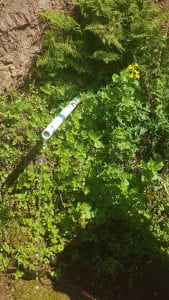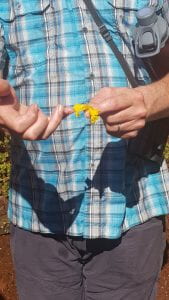On 10/22/19 at 02:30 PM, we started to undergo Modified Alexander et al. tube protocol for DNA extraction. First of all, I labeled 3 2.0 mL tubes with the sample codes as follows; EO01, EO02, AND EO03. Then, I added three sterile 3.2-mm stainless steel beads to each tube. I added a small amount of leaf tissue to each tube; from E.O. cATB to EOO1, JP MW 03 to EO02 and SHOR 004 to EO03, using tweezers and I sterilized the tool after each trial. Next, I loaded the tubes within a tube rack into the modified reciprocating saw rack and Hannah mounted the rack to the saw. I briefly spin down the tubes in the centrifuge to pull plant dust down to the lids. I added 434uL preheated grind buffer to each tube. I incubated buffered grindate at 65°C for 10 min in water bath, mixing the tubes by inversion every 3 min. After that, I added 130 uL 3M pH 4.7 potassium acetate, inverted tubes several times and incubated on ice for 5 mins. I span the tubes in a centrifuge at maximum force for 20 mins. I labeled new 1.5 mL tubes with the sample IDs as follows; EO-01, EO-02, EO-03. I transferred the supernatant to these sterile 1.5mL micro centrifuge tubes. I added 600 uL of binding buffer to each tube. Then, I applied 640uL of mixture from the previous step to Epoch spin column tubes and centrifuged for 10 min. After that, I disposed the buffer into the hazardous-waste container. I repeated this step with the remaining volume. I washed the DNA bound to the silica membrane by adding 500uL of 70% EtOH to the column and centrifuge at 15,000 rpm until all liquid has passed to the collection tube and discarded the flow-through. I repeated the previous step and discarded the flow-through again. After that, I centrifuged the columns at 15,000 rpm for an additional 5 min to remove any residual ethanol. I discarded the collection tubes and placed the columns in sterile 1.5 mL micro centrifuge tubes with the labels as follows; EO cATB 10/22/19, JP MW 03 10/22/19, SHOR 004 10/22/19. I added 100uL preheated pure sterile H20 to each tube and let it stand for 5 min. Finally, I centrifuged the tubes for 2 min at at 15,000 rpm to elute the DNA.
Monthly Archives: October 2019
Phylogenetic Inference
On Tuesday, 10/08/2019 at 02:30 PM, we’ve started our lab session. We had to use to edit the alignments we made last week, but as my Geneious free trial has expired, I couldn’t work on my own project, instead, I had to work with Jason. We first cleaned up his alignment by editing it down. Then, we used a program called JModelTest2 to figure out the best model of molecular evolution for his sequences. We downloaded the jModelTest2 from canvas and then we went back to Geneious and exported his alignment in Phylip format. We opened the exported alignment on JModelTest2 and computed likelihood scores. After the calculations were done, we chose the best model based on Akaike Information Criterion and Bayesian Information Criterion. In Geneious, we looked at the choices for a MrBayes analysis. After that, we used maximum likelihood to infer a phylogenetic tree of his aligned data set.
An Introduction to Geneious
On Tuesday, 10/01/2019 at 02:00 PM, we started out dry lab session using Geneious software. I’ve previously downloaded this software during summer to analyze sequences from Prof. Zimmerman’s Lab, so my free trial expired prior to lab session. I had to connect to the operating system on the basement server that is hosting the 2 Geneious floating licenses. Next, I selected the local folder and created a new folder called “Molecular Ecology Fish Barcodes”. After that, I downloaded the classes DNA barcoding sequences from Canvas. When the folders were downloaded, I dragged and dropped them into my Fish Barcode Folder. I created another file called “Emre Ovet Fish Barcodes and dropped two forward and reverse sequence files there. Then, I assembled the forward and reverse sequence reads of the same sample. I opened those assembly sequences, trimmed the low quality bases and fixed the ambiguities. Next, I generated consensus sequences and blasted them. The top hit for my sequence EO01 was Pseudomonas fragi which is a gram negative bacterium and the second hit was Clarias gabonensis which turns out to be a catfish species. This sample was labeled as Coho Salmon in the supermarket. The top hit for my sequence EO04 was Thunnus albacares which is Ahi Tuna. It was labeled as such in the supermarket. After the Blast results, I’ve builded alignments with my sequences. EO01 didn’t match the species I was supposed to have been served but EO04 did. Moveover, EO01 had a total of 106 polymorphic sites and EO04 had 40.
Second Outdoor Trip
On Tuesday 10/25/2019 at 02:00 PM, we took a ride with Alec to a location nearby Mt. Tamalpais (37°53’22.0″N, 122°37’46.7″W). Here, we observed a perennial mimulus population next to a fresh water source. We talked about the possible benefits of this wet habitat for the survival and reproduction of the species and we analyzed an opened mimulus flower.
After filling our bottles with fresh spring water, we took another short car ride to a different location (37°52’37.5″N, 122°34’52.2″ W). We walked along a creek that brought us to a shady environment that was surrounded by trees. Our task was to find another mimulus population, but the plants in this area didn’t blossom at the time which made the task more difficult.
While looking for the mimulus, we discussed that the mimulus population in this environment can survive only for a few months because floods take place in the area during winter. After someone found a mimulus, Alec was able to collect leaf samples from the plant, thus, our goals for this trip were accomplished and we made our way back to campus.




